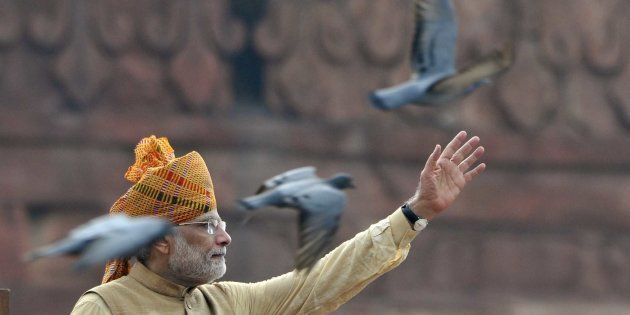

Previous Page >> 4 Lessons In Change Leadership From Modi’s ‘Surgical Strike’ On Black Money
4 Lessons In Change Leadership From Modi’s ‘Surgical Strike’ On Black Money

The recent surgical strike on black money is truly a bold move. Not surprising, industry doyens, economists and even the IMF have given Prime Minister Narendra Modi the thumbs-up. Beyond the benefits that it will bring to India, what’s interesting for me is that it provides great lessons on how to drive transformative change. These takeaways can be applied to any context and organisation, irrespective of whether you are in government, private sector, social sector, education or anywhere.
Perception matters as much as impact
One of Modi’s election promises was to remove corruption from India. One estimate, in fact, says that wealth from corruption comprises a fifth of India’s GDP. Since coming to power, the government has taken series of steps which led to ₹1 .25 lakh crore in black money coming out in open. Some of the steps taken so far include setting up of a SIT (special investigation team) to get back money stashed abroad by wealthy Indians, implementation of the Black Money and Imposition of Tax Act, 2015, renegotiation of tax treaties, Income Declaration Scheme etc.
Modi has made the experience of change very visceral for people — this exercise is not something they will forget.
While these were great steps, none of them seemed to register in the minds of the common people — the masses that make up the bulk of the nation. Not surprisingly, earlier this year, Transparency International’s Corruption Perception Index found that India on a scale of 100 was perceived as scoring 38 in corruption in 2015, the same as the previous year. Clearly, while the government has not been hit by scams, the people thought that its promises to bring back black money were not coming to fruition.
However, this demonetisation scheme is a masterstroke for the government in terms of winning the perception game. With his “financial surgical strike”, Modi has positioned himself as someone who walks the talk.
Yes, citizens are enduring great inconvenience, but if you watch interviews with people on the street, you will see that most of them believe it’s a move in the right direction; a recent poll found that 82% of people were in favour of demonetisation. There seems to be a belief that this move will help to clean up the nation. Now what Modi has done is that he has made the experience of change very visceral for people. They are going through the pain but know that their ‘sacrifice” is for a good cause — this exercise is not something they will forget. Modi to them has become the messiah of black-money elimination. For them it does not matter how much black money will actually be obliterated but since they are experiencing it, feeling it, it will be etched in their mind.
What leaders driving organisational change should learn is that together with real impact, it’s important to make sure an impact is felt in the mind as well. People shouldn’t just “know” things have changed, they should “feel” it and believe it.
Know when NOT to get stakeholder buy-in
In a change effort, it is key that stakeholders buy into what is getting deployed to make sure they participate in the effort and support it. Without this there could be resistance which delays and even derails the process. However, there are instances when specific actions need to be taken and one has to go all alone. For reasons ranging from the need for confidentiality to the sensitive nature of a matter to security issues, these steps are taken because it’s the right thing to do for a larger objective. This is based on the leader’s convictions and he or she makes the decision unilaterally or in consultation with close confidants.
When trying to do something transformational be ready to put your neck on the line. You can’t be in a comfort zone and drive change.
This is exactly what Narendra Modi did. His larger objective was to make a corruption-free India, which is something he has spoken about publicly often. However, in the matter of demonetisation, secrecy was necessary (only a handful of people knew about it) so that black money hoarders wouldn’t have advance warning to launder their assets or get rid of them.
The learning for change leaders is that there could be instances in a transformation effort when a leader has to go it all alone without getting buy-in. This is sometimes required for the success of a larger mission.
People’s actions change when they know they’re being watched
During a nine-year study at Western Electric’s Hawthorne plant in the 1930s, researcher Elton Mayo found that employees’ productivity improved when they knew they were being observed. This was called Hawthorne Effect and has been replicated in other contexts as well. For example, in 2011, when researchers of Carnegie Mellon University sent weekly postcards to customers of an electric company, informing them that their consumption was being watched, it resulted in a reduction of electricity use by consumers. There were also allegations in the US media about the Obama administration applying this technique to keep surveillance on government employees.
I believe something similar will happen here. After the demonetisation scheme, citizens will be aware of the heightened monitoring by tax authorities; this will change the behaviour of tax defaulters and the like who will be more likely to declare their money going forward. While the problem of black money may not be completely eliminated, there will be an improvement due to the change in many people’s behaviour.
The takeaway for those wanting to drive a change in behaviour is to tell the subjects that they are under scrutiny.
Be ready to take major risks
When trying to do something transformational, be ready to put your neck in the line. You can’t be in a comfort zone and drive change. This is what Narendra Modi has done. Taking a decision such as the current demonetisation is not easy — there’s major disruption and it can backfire in a big way if normalcy is not restored soon. If the cash is not replenished soon, the common person might have to endure substantial hardship; matters might be even worse in villages where banking penetration is weak. Also, the trader community that deals mostly in cash might suffer huge losses and might turn on the BJP that it has traditionally supported. And then of course there are protests in the Opposition, which could impact the functioning of Parliament. But Narendra Modi is a fearless leader who is driven by conviction. He knew he has to weed out corruption for the greater good of the nation even if it means alienating a few supporters.
The takeaway for change leaders is that you have to be prepared to become unpopular while you’re driving a transformation in the organisation. Ultimately, your actions actions need to be driven by the larger objective of the change effort.










